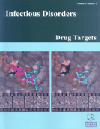- Home
- A-Z Publications
- Infectious Disorders - Drug Targets (Formerly Current Drug Targets - Infectious Disorders)
- Previous Issues
- Volume 7, Issue 1, 2007
Infectious Disorders - Drug Targets (Formerly Current Drug Targets - Infectious Disorders) - Volume 7, Issue 1, 2007
Volume 7, Issue 1, 2007
-
-
Editorial [ Infectious Diseases: What is in our future? ]
More LessCurrent Drug Targets-Infectious Disorders (CDT-ID) was launched in May of 2001 and is now starting its seventh year with the March 2007 issue, although under a new name: Infectious Disorder - Drug Targets. Special Topics issues, organized by a Guest Editor, are published twice a year and have been well received since their inception in 2001. Two Special Topics issues are scheduled for 2007: 1) Drs. Robert Goldman and Bar Read More
-
-
-
Exploring DNA Topoisomerases as Targets of Novel Therapeutic Agents in the Treatment of Infectious Diseases
More LessDNA topoisomerases are ubiquitous enzymes needed to overcome topological problems encountered during DNA replication, transcription, recombination and maintenance of genomic stability. They have proved to be valuable targets for therapy, in part because some anti-topoisomerase agents act as poisons. Bacterial DNA gyrase and topoisomerase IV (type IIA topoisomerases) are targets of fluoroquinolo Read More
-
-
-
Novel Targets for the Development of Anti-Herpes Compounds
More LessAuthors: A. Greco, J-J. Diaz, D. Thouvenot and F. MorfinHerpes simplex virus type 1 (HSV-1) and herpes simplex virus type 2 (HSV-2) are members of the Herpesviridae family. HSV infections have been known since ancient times and are one of the most common communicable diseases in humans. Although infections are often subclinical, HSV can cause mild to severe diseases, especially in immunocompromised patients. Herpes simplex viruses establish latency in the nuclei of neur Read More
-
-
-
Targeting Bacterial Secretion Systems: Benefits of Disarmament in the Microcosm
More LessAuthors: Christian Baron and Brian CoombesSecretion systems are used by many bacterial pathogens for the delivery of virulence factors to the extracellular space or directly into host cells. They are attractive targets for the development of novel anti-virulence drugs as their inactivation would lead to pathogen attenuation or avirulence, followed by clearance of the bacteria by the immune system. This review will present the state of knowledge on the assembly and functi Read More
-
-
-
Recent Developments in the Virology and Antiviral Research of Severe Acute Respiratory Syndrome Coronavirus
More LessAuthors: Kap-Sun Yeung and Nicholas A. MeanwellThis article summarizes the significant developments and new discoveries in both the virology and antiviral research associated with the severe acute respiratory syndrome coronavirus (SARS CoV) that were reported in 2005 and 2006. Areas reviewed include genomic studies and the identification of bat-SARS CoV, spike protein and host cell entry, nucleocapsid protein, accessory proteins, non-structural proteins of the Read More
-
-
-
Antibiotic Resistance During Therapy: Mechanisms and Means of Control
More LessAuthors: J. C. Rodriguez, E. Pastor, M. Ruiz, E. Flores and G. RoyoAntibiotic resistance is a serious public health problem. The most effective way to control this phenomenon is to make rational use of antibiotics. However, antibiotic resistance is a complex process in which clinical, pharmacodynamic, pharmacokinetic and microbiological factors all play a part. Since antibiotic therapy is usually performed empirically, clinicians should follow guidelines that take all these factors into account t Read More
-
-
-
Strategies to Design Inhibitors of Clostridium Botulinum Neurotoxins
More LessAuthors: S. Cai and B. R. SinghBotulinum neurotoxins (BoNTs), produced by spore-forming anaerobic Clostridium botulinum, are the most toxic substances known. They cause the life-threatening disease botulism, characterized by flaccid muscle paralysis. While the natural cases of botulism are rare, due to their extreme toxicity and easy production, BoNTs have become potential biowarfare agents, and create maximum fear among populations concerned Read More
-
-
-
Antiviral Strategies Against Human Coronaviruses
More LessAuthors: K. Pyrc, B. Berkhout and L. van der HoekSince the mid 60's the human coronaviruses (HCoV), represented by HCoV-OC43 and HCoV-229E, were generally considered relatively harmless viruses. This status changed dramatically with the emergence of SARS-CoV in 2002/2003. The SARSCoV pandemic took 774 lives around the globe and infected more than 8000 people in 29 countries. SARS-CoV is believed to be of zoonotic origin, transmitted from its natural reservoir Read More
-
-
-
Human Defensins: Turning Defense into Offense?
More LessAuthors: Erik de Leeuw and Wuyuan LuDefensins are a family of antimicrobial cationic peptides that act as a rapid response force against microbial invasion in a wide range of organisms, including plants, insects, animals and humans. In humans, defensins are produced predominantly by leukocytes and epithelial cells and are an important factor of innate immunity. In addition to their major role as natural antibiotics, defensins are increasingly recognized as signali Read More
-
Volumes & issues
-
Volume 25 (2025)
-
Volume 24 (2024)
-
Volume 23 (2023)
-
Volume 22 (2022)
-
Volume 21 (2021)
-
Volume 20 (2020)
-
Volume 19 (2019)
-
Volume 18 (2018)
-
Volume 17 (2017)
-
Volume 16 (2016)
-
Volume 15 (2015)
-
Volume 14 (2014)
-
Volume 13 (2013)
-
Volume 12 (2012)
-
Volume 11 (2011)
-
Volume 10 (2010)
-
Volume 9 (2009)
-
Volume 8 (2008)
-
Volume 7 (2007)
-
Volume 6 (2006)
Most Read This Month
Article
content/journals/iddt
Journal
10
5
false
en


